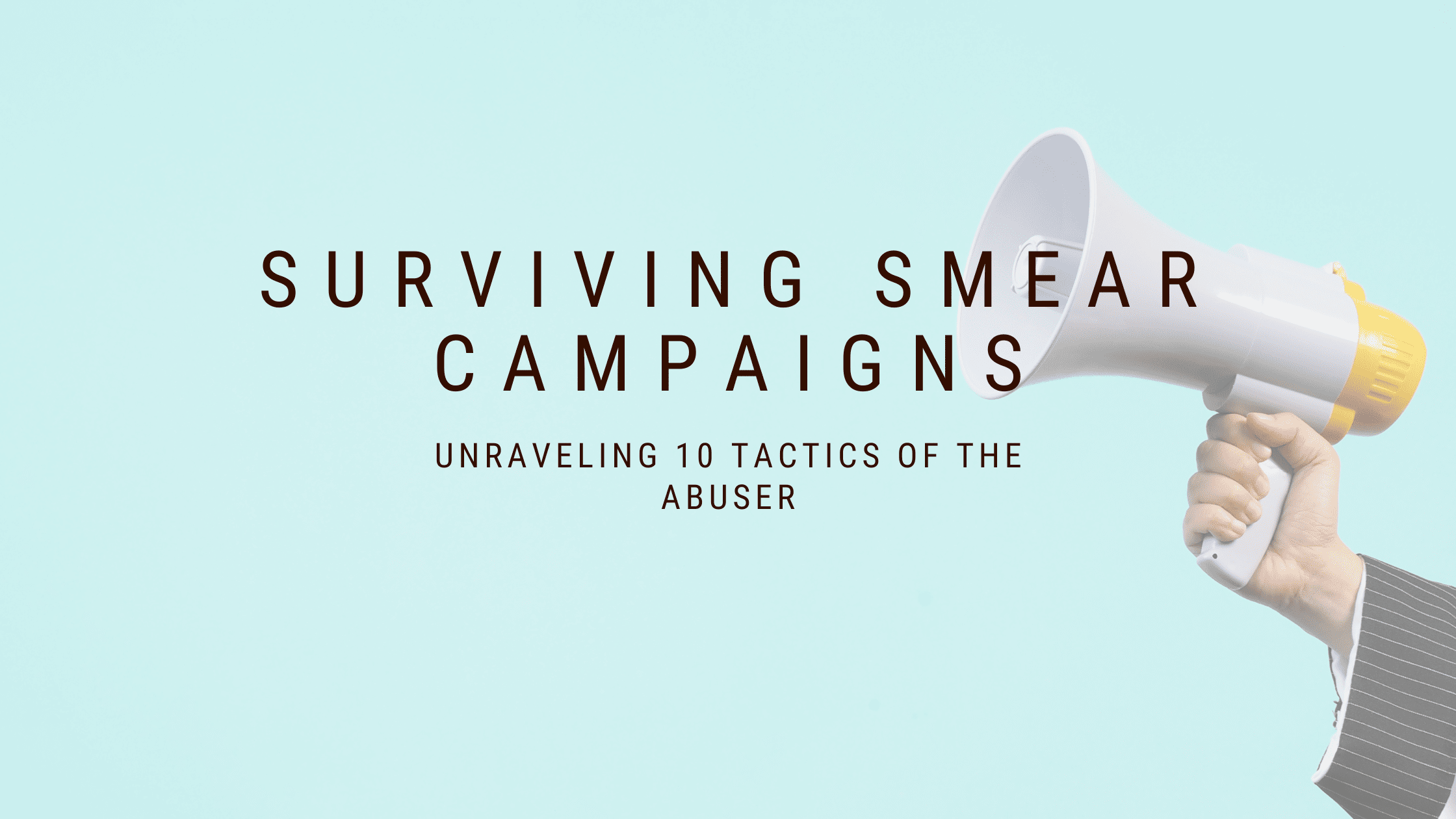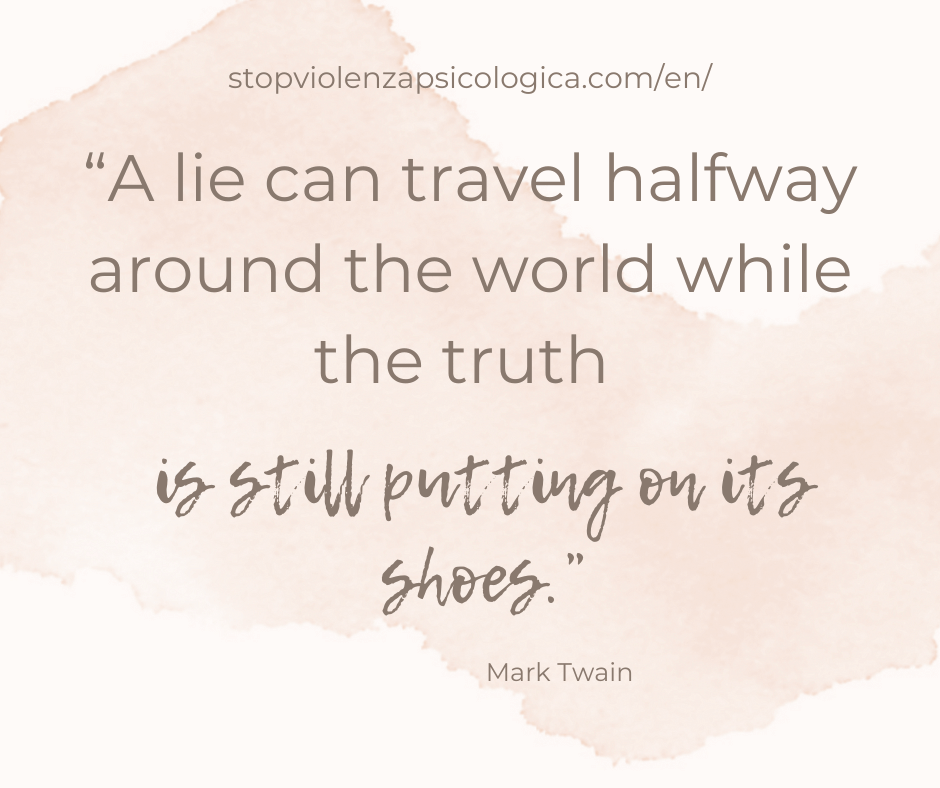When Abuse Continues: The Truth About Smear Campaigns

Smear campaigns are tactics used by abusers to discredit their victims. These campaigns involve a series of actions aimed at spreading false or distorted information to damage the victim’s reputation.
These attacks become particularly virulent when the victim decides to leave the abusive relationship.
Defamation is a form of psychological abuse that can have severe emotional and social consequences.
Why It’s Important to Talk About It
Addressing the issue of smear campaigns is crucial for several reasons. First, recognizing and understanding these manipulative tactics allows for proper support to be provided to victims, who often find themselves isolated and without resources. Defamation can have devastating effects on victims’ mental, emotional, and social well-being, compromising their ability to live a peaceful and productive life. Awareness and education on this topic can help break the cycle of abuse and prevent further harm.
Moreover, spreading information about smear campaigns is essential to educating the public on how to recognize signs of psychological abuse and manipulation. This can lead to greater community support for victims, creating support networks that are essential for their healing and well-being.
Stigmatizing defamation and encouraging the reporting of such behaviors can also deter abusers from continuing to use these tactics.
Finally, understanding the dynamics of smear campaigns is crucial for promoting justice and fairness in legal contexts. When victims are aware of the tactics used against them, they are better equipped to defend themselves and present effective evidence in court. This can lead to fairer legal decisions and greater protection for abuse victims.
In essence, addressing this issue not only helps victims recover and rebuild their lives but also contributes to a more just and compassionate society.

Context of Smear Campaigns
Abusers often use control and manipulation as primary tools to maintain power over their victims. These power dynamics intensify when the victim attempts to leave the abuser, as the latter perceives the loss of control as a threat to their authority. In this context, smear campaigns become a strategy to restore dominance and punish the victim for their independence. Abusers seek to further isolate the victim by spreading lies and manipulating the opinions of friends, family, and colleagues. This systematic attack can leave the victim without support, making them feel even more vulnerable and powerless.
A thirst for revenge is another key factor that motivates abusers to launch smear campaigns.
Feeling threatened and humiliated by the victim’s decision to end the relationship, abusers seek to destroy their reputation as a form of retaliation. Revenge becomes a means to reestablish their sense of control and power.
Besides revenge, abusers often feel the need to maintain a false social image and status, built during the relationship with the victim. This facade of respectability and success is crucial for the abuser, who fears being exposed for their true abusive behavior.
Defaming the victim serves to divert attention from their flaws and maintain their reputation intact.
In this way, the abuser can continue to garner sympathy and support from their social circle, further strengthening their control and isolation of the victim.
Understanding this context is essential to recognize smear campaigns and provide victims with the necessary support to confront them.
“Ever since she got pregnant, she seems to have gone out of her mind.”
The Abuser

Common Smear Tactics
Abusers’ smear tactics can vary but often include the distortion of truth and spreading false accusations. Abusers manipulate reality to make the victim appear unstable, irresponsible, or even dangerous. For example, they might accuse the victim of infidelity, substance abuse, or financial mismanagement. Another common tactic is using social media to amplify lies, engaging a wider audience and making it harder for the victim to defend themselves. Abusers may create manipulative posts, share them in groups, and try to convince mutual friends of their version of events. These tactics not only damage the victim’s reputation but can also have a lasting impact on their social and professional life.
Here are the 10 most common smear tactics:
1. Distortion of the Truth
– Manipulating and altering facts to make the victim seem unstable or unreliable. The abuser may exaggerate or distort real events to paint the victim in a negative light.
2. Accusations of Mental Problems
– Spreading rumors that the victim suffers from mental disorders, such as postpartum depression, to discredit them and divert attention from their own abusive behaviors.
3. Accusations of Infidelity
– Accusing the victim of cheating or infidelity to undermine their credibility and justify their own abusive actions.
4. Spreading Lies on Social Media
– Using platforms like Facebook, Twitter, and Instagram to share lies and insinuations, reaching a broad audience and increasing the damage to the victim’s reputation.
5. Manipulation of Friends and Family
– Convincing mutual friends and family of their version of events, further isolating the victim and making them appear to be the cause of the problems.
6. Accusations of Substance Abuse
– Falsely claiming that the victim is addicted to drugs or alcohol to undermine their reliability and competence, especially in legal or professional contexts.
7. Lying About the Victim’s Work
– Spreading false information about the victim’s job performance, jeopardizing their career and professional opportunities.
8. Creating False Evidence
– Producing or falsifying documents, messages, or other evidence to support their accusations and further damage the victim’s reputation.
9. Accusations of Abuse or Violence
– Reversing roles by accusing the victim of being the abuser, exploiting sympathy and support from third parties to strengthen their position.
10. Diminishing and Ridiculing the Victim
– Ridiculing the victim’s experiences and emotions, making them appear overly dramatic or exaggerated to others.
These tactics, though varied, all aim to damage the victim’s reputation and maintain the abuser’s control. Recognizing them is the first step to effectively countering them.

Motivations of Abusers
Abusers use smear campaigns primarily to maintain control and power over the victim. When a victim seeks to break free from the abusive relationship, the abuser perceives this action as a direct threat to their authority. Smear campaigns are therefore a form of revenge and a means to reaffirm their dominance.
Additionally, abusers seek to protect their public image. Defaming the victim serves to divert attention from their abusive behaviors and maintain a facade of respectability. Smear campaigns are thus a powerful tool for abusers, who aim to destroy the victim’s credibility and maintain control.
Here is a list of the most common motivations driving abusers to smear their victims:
1. Maintaining Control
– Abusers want to continue exerting power over the victim even after the relationship ends. Defamation is a means to maintain control and keep the victim in a state of fear and submission.
2. Revenge
– The victim’s decision to leave the abuser is perceived as a challenge to their authority. Defamation becomes a tool of revenge to punish the victim for their independence and for daring to challenge the abuser.
3. Protecting Their Image
– Abusers often build an image of respectability and success. Defaming the victim helps divert attention from their abusive behaviors, keeping their public facade intact and deceiving those around them.
4. Isolating the Victim
– Spreading lies and slander serves to further isolate the victim, depriving them of the support of friends and family. This isolation makes the victim more vulnerable and less capable of defending themselves.
5. Avoiding Legal Consequences
– Defamation can be used to discredit the victim in legal contexts, making it harder for them to obtain protection or justice. The abuser seeks to influence judges and lawyers, portraying the victim as unstable or unreliable.
6. Projecting Blame
– Abusers often project their own faults and negative behaviors onto the victim. Accusing the victim of behaviors they themselves have engaged in serves to confuse and manipulate the perception of reality.
7. Gaining Sympathy and Support
– By portraying themselves as the real victim, the abuser seeks to gather sympathy and support from friends, family, and colleagues. This strengthens their position of power and makes it harder for the victim to find allies.
8. Controlling the Narrative
– Abusers want to be the ones telling the story. Controlling the narrative allows them to shape others’ perceptions and maintain their dominance over the circumstances and people involved.
9. Minimizing Their Psychological Problems
– Defamation also serves to hide any psychological problems or disorders they may have. Accusing the victim of mental instability diverts attention from their own psychological issues, maintaining a facade of normalcy.
10. Avoiding Acknowledgment of Failure
– Abusers often cannot accept the failure of the relationship as their own responsibility. Defaming the victim is a way to avoid confronting their own failure and place the blame on the other.
Understanding these motivations is crucial to recognizing abusers’ tactics and adequately supporting victims in their fight against smear campaigns.

Effects on Victims
Smear campaigns can have devastating effects on victims, both emotionally and psychologically. Continuous exposure to lies and slander can lead to feelings of anxiety, depression, and isolation. The victim may start to doubt themselves and their perceptions, developing low self-esteem and a sense of helplessness.
Socially, defamation can destroy personal and professional relationships. Friends and family may distance themselves, believing the lies spread by the abuser. At work, a tarnished reputation can affect career opportunities, making it difficult to obtain or maintain employment. Victims can feel trapped in a web of injustice and suffering, with long-term consequences for their mental health and overall well-being.

Defamation can have particularly serious effects in court. When the victim seeks justice through the legal system, the slander spread by the abuser can undermine their credibility in the eyes of judges and lawyers. Abusers often portray the victim as unstable and unreliable, manipulating evidence and testimony to support their accusations. This can lead to a lack of trust in the victim’s statements, making it difficult to obtain restraining orders or other forms of legal protection. In some cases, defamation can influence decisions regarding child custody, with the abuser managing to gain an unfair advantage by exploiting the negative perception created around the victim.
This not only prolongs the abuse but also adds an additional layer of trauma and injustice for the victim,
who is denied justice and protection just when they need it most.

Defense Strategies for Victims
Victims can adopt several strategies to defend themselves against defamation campaigns. One of the first actions is to document all defamatory attacks by collecting evidence such as messages, emails, and social media posts. This evidence can be useful in a legal context to prove abusive behavior. It is crucial to seek legal support from a lawyer specializing in defamation or domestic violence, who can advise on the best course of action.
Psychological support is equally important. A psychotherapist can help the victim manage stress and rebuild their self-esteem. Building a reliable support network of friends, family, and support groups can provide both emotional and practical support.
However, in my opinion, unless strictly necessary or essential, such as for a career or in court, victims should not waste time defending themselves against defamation or justifying every lie of the abuser. True friends know or sense the truth, and it is better to focus on overcoming the trauma of the abuse and starting to live a peaceful life away from the abuser. The truth will come out sooner or later anyway. This perspective allows victims to concentrate on their healing journey rather than the negative energy generated by the abuser. Ignoring the slander and focusing on their well-being is often the healthiest and most constructive way to recover and move on with their lives.

Role of Society
Society has a crucial role in countering smear campaigns and supporting victims. Education and awareness are key: it is essential to promote awareness about defamatory tactics and teach people how to recognize them.
Educational programs in schools and information campaigns can help create a culture of respect and support. Institutions must provide adequate resources for victims, such as accessible legal and psychological services and support networks. Laws on defamation and protection for domestic violence victims must be strengthened and strictly enforced. Society must also foster a culture that does not tolerate abusive behavior and supports victims in their struggle for justice and healing.
Only through collective efforts can we hope to effectively counter smear campaigns and help victims rebuild their lives.
“A lie can travel halfway around the world while the truth is still putting on its shoes.”
Mark Twain

This quote highlights how quickly lies and defamation can spread, causing significant harm to victims, while the truth takes longer to emerge.

Conclusion
Smear campaigns are a powerful and destructive tool used by abusers to maintain control over their victims.
Recognizing and addressing this form of abuse is crucial for supporting victims and preventing further harm.
Understanding the motivations behind smear campaigns, the common tactics used, and the devastating effects on victims is essential to provide effective assistance and promote justice.
It is important to remind victims that
they are not alone
and that there are resources and people ready to help them.
With the right awareness and action, we can work together to create a safer and more supportive environment for everyone.
I sincerely hope this post was helpful to you. I encourage you to share this awareness with your friends by spreading this post and leaving me a comment below. Thank you!

